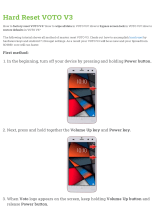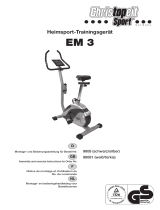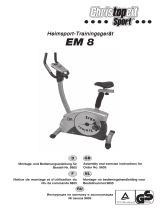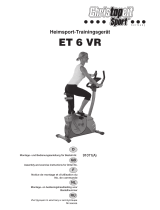Page is loading ...

FB600
Trainings- und Bedienungsanleitung
Training and Operating Instructions
Mode d’emploi et instructions d‘entraînement
Trainings- en bedieningshandleiding
Instrucciones de entrenamiento y manejo
Istruzioni per l'allenamento e per l’uso
Instrukcja treningowa i instrukcja obsługi
Návod k obsluze a tréninku
Instruções de treino e utilização
Trænings – og betjeningsvejledning
Navodilo za trening in upravljanje
Tréning és használati útmutató
deutsch
english
française
nederlands
español
italiano
polski
cestina
português
dansk
slovensko
magyarul

Table of contents 12
Safety notes 12
• Service 12
• Your safety 12
Short description 13-15
• Function range / Buttons 3
• Indicating range / Display 14-15
Settings 16
• Time 16
• Metric / Imperial 16
Training 17
without presetting 17
with presetting 17
• Time 17
• Distance 17
• Energy (KJoule/kcal) 17
• Pulse monitoring 17
• Training interruption 17
• Stand-by mode 17
• Resumption of training 18
• Recovery (recovery pulse measure-
ment) 18
Recall last training 18
• Last training values 18
• Total kilometres 18
General instructions 19
• System signals 19
• Recovery 19
• Calculation of average value 19
• Notes on pulse measurement 19
With ear clip 19
With chest belt 19
With hand pulse 19
• Errors of the computer 19
• Battery change 19
Training instructions 19
• Stamina training 19
• Strain intensity 19
• Duration of strain 19
12
GB
Training and Operating Instructions
For your safety:
• Please clarify with your general practitioner before you start
with the training, whether or not your health condition allows
you to train with this device. The diagnostic findings should
be the basis for the determination of your training program-
me. Wrong or excessive training can cause damage to your
health.
Safety instructions
Please observe the following instructions for your own
safety:
• The training device must be set up on an appropriate and
firm surface.
• Inspect the connections for firm fitting before initial operation
and additionally after approximately six operation days.
• In order to prevent injuries caused by wrong stress or over-
stress, the training device may only be used in accordance
with the instructions.
• It is not recommended to permanently set up the device in
humid rooms due to the resulting corrosion development.
• Assure yourself regularly that the training device functions
properly and that it is in duly condition.
• The operator is responsible for the safety controls, which
have to be carried out on a regular and proper basis.
• Defective or damaged parts must be exchanged immediately.
Only use original KETTLER spare parts.
• The device may not be used until after repairs are comple-
ted.
• The safety level of the device can only be maintained provi-
ded that it is regularly inspected for damage and wear and
tear.

13
GB
FB600
Short description
The electronics assembly has the following functions:
• Total kilometres are saved
• Last training is saved
• Presetting is saved
• Pulse display without training possible
• Switch between kilometres and miles
Function range
The four buttons will be described in short below.
DISP (press shortly)
• Switches from time display to ready for training
• Stops or starts display change.
• Switches to next input range.
Settings or values will be accepted.
DISP (press longer) RESET
• Deletes display for a reset.
Only possible in standstill..
Minus – / Plus +
With these function buttons, you can change the values in
the different input data before the start of the training
• Press longer > fast run through the values
• Press “Plus” and “Minus” together: input data will be
reset )
Minus – (press shortly when time is displayed)
• Display of last training data (MEM) and total kilometres
(ODO))
Minus – (press longer when time is displayed)
• Set time (TIME)
• Switch from ME to IM (SETTINGS)
ME = [24h], [KJoule], [kilometres] -display
IM = [12h], [Kcal], [miles] -
Plus + (press longer)
• Recall of training presetting
REC (recovery pulse with fitness mark)
By pressing this function button, the recovery pulse functi-
on is started and a fitness grade is calculated.
Measuring the pulse
The measurement of the pulse can be carried out by
means of 3 sources:
1. Ear clip -
The plug is put into the socket.
2. Hand pulse
The connection is situated at the back of the display;
3 Breast belt with plug recipient (available as accessory)
Please observe the respective instructions.

Indicating range / Display
The display informs you about
the different functions.
Training time
(EX.TIME)
Time
24 hours or 12 hours
AM/PM
Pedalling frequency
(RPM)
Display from
3,9 – 70,6 km/h
2,4 – 43,9 m/h
Distance (DIST) KM
or Mi
Speed (KM/H) or (Mi/H)
Display from
0,00 – 99,99
Display from
0:00 – 99:59
Display from
11 – 199
14
GB
Training and Operating Instructions

Display from
40 – 220
Pulse
Display from
0 – 9999
Last training values will be
displayed
MEM
last trainings values are dis-
played
Energieverbrauch
Energy consumption
(KJOULE)
or (KCAL)
Odo
Total k(m) will be displayed
Display from 0 – 9999
Heart symbol (flashes), if
signal recognised
Animation wheel
Training mode
Pedal rotation will be identified
Symbols
Meaning
Change of display active
Battery charge low
Change battery
Training goals available
Input training goals
IM setting
[12h], [Kcal], [miles]
15
GB
FB600

16
GB
Training and Operating Instructions
Settings
Time
and
ME = [24h], [KJoule], [kilometres] -display
or
IM = [12h], [Kcal], [miles] –display
• Minus – (press longer when time is displayed)
Hours flash
• press Minus – / Plus +
Set hour
• press DISP
Minutes flash
• press Minus – / Plus +
set minutes
• press DISP
• Minus – / Plus +
Set to IM or ME
• press DISP
Time will be displayed

17
GB
FB600
Training
1. Training without presetting / Pulse mea-
surement
• press DISP
Training time “EX.TIME” will be displayed.
or
Pulse value will be displayed if a pulse signal is identified
via ear clip, hand pulse or plug recipient.
and / or
• Start pedalling
Training time “EX.TIME” and the following displays will
be increasingly displayed.
Change of display is active
Animation wheel is active
2. Training with presetting
Presetting values can be entered for time, distance and
energy. With start of training, such entered values will
count down. If zero is reached, the display will flash and
a signal will sound. Then, the presetting value will conti-
nue to count up. When switch display mode is active, the
range will be displayed which will reach zero first. A
value can be entered for pulse which will sound an alarm
signal as soon as reached.
• Press longer Plus
Display:
“TIME” presetting
Time setting (EX.TIME)
• Enter values using “Plus” or “Minus” (e.g. 30:00)
• Confirm with “DISP”.
Display:
next setting ”DISTANCE”
Distance setting (DIST)
• Enter values using “Plus” or “Minus” (e.g. 780)
• Confirm with “DISP”.
Display:
next setting “ENERGY”
Energy setting (KJOULE or KCAL)
• Enter values using “Plus” or “Minus” (e.g. 780)
• Confirm with “DISP”.
Display:
next setting “age input“
Pulse monitoring with alarm signal
• Enter value using “Plus” or “Minus” (e.g. 131)
• Confirm with “DISP” (presetting mode completed)
Display:
ready for training with time setting
• Pedalling ill start the training
Presetting values displayed will count down.
Change of display is active
Animation wheel is active
• Pressing “DISP” will stop and start change of display.
• The presetting symbol will be hidden if all presetting is
counted down to zero.
• The presetting will be saved and will be re-display-
ed with the next training.
Note:

18
GB
Training and Operating Instructions
Training interruptiTraining interruption/end
of training
With less than 10 pedal rotations per minute, the electro-
nics assembly of the training device identifies a training
interruption. The animation wheel is displayed empty. The
achieved training data are displayed. Rotations, speed
and pulse level are displayed as average values with the
symbol Ø.
• Pressing “DISP” will stop and start change of display.
The training data are displayed for 4 minutes. If you do
not press any button nor train during this period of time,
time electronics assembly of the training device switches to
standy-by mode and displays the time.
Training interruption is identified with a delay of a few
seconds.
Resumption of training
If you resume training within 4 minutes, the last values
continue to be counted up or down.
RECOVERY – Function
Recovery pulse measurement
Press “RECOVERY” at the end of training.
The electronics assembly of the training device measures
your pulse 60 seconds in reverse.
The difference between start pulse and end pulse helps to
determine a fitness grade (see example F 1.6). The dis-
play will be stopped after 20 seconds.
“RECOVERY” interrupts the recovery pulse function or the
fitness mark display.
If no pulse is measured in the beginning or at the end of
the reverse counting, the error message “Err” is displayed.
Recall last training (MEM) with total kilome-
tres (ODO)
When pressing RESET or switching off the display (stand-
by), the last training values are saved automatically.
Recall of last training data
• Minus – (press shortly when time is displayed)
All segments are shortly displayed
The last training time is displayed
• Press DISP
The display skips to the next range.
Stopping last display of training data
• Press Minus
Comment:

19
GB
FB600
Battery change
If the empty battery symbol appears in the display, the batteries
should be replaced. The total kilometres, presetting and last trai-
ning values get lost. Time must be reset.
Brake level display
Brake setting is classified in level 1-10. If this classification is
disturbed or lost, you must restore it as follows:
• Check whether the 3-pole connecting cable is plugged in at
the back of the display.
• Insert batteries and press the ”DISP/SET” button until the seg-
ment test is completed.
• Turn back hand lever to minimum setting and press the
”DISP/SET” button when 0%, BRAKE 0 is displayed.
• Pre-turn hand lever to maximum setting and press the
”DISP/SET” button when 100%, BRAKE 10 is displayed.
The process is completed.
Training instructions
Sports medicine and training science use cycle ergometry,
among other things, for the examination of the functional capa-
bility of heart, circulation and respiratory system.
You can find out whether or not you have achieved the desired
effect from your training after several weeks using the following
method:
1. You manage a particular endurance performance with less
heart / circulation performance than previously
2. You sustain a particular endurance performance with the
same heart / circulation performance over a longer period.
3. You recover more quickly than previously after a particular
heart / circulation performance.
Guide values for the endurance training
Maximalpulse: maximum strain means the reaching of the indi-
vidual maximum pulse. The maximum achievable heart rate is
dependant on age.
Here the following empirical formula applies: the maximum
heart rate per minute corresponds to 220 heart beats minus age
in years.
Example: age 50 years -> 220 – 50 = 170 pulse/min.
Load intensity
Load pulse: the optimum intensity of load is reached at 65–
75 % (see also diagram) of the maximum pulse. This value
changes depending on age.
Pulsediagramm
Fitness and Fat Burner
220
200
180
160
140
120
100
80
Pulse
Ag
e
20 25 30 35 40 45 50 55 60 65 70 75 80
Maximalpulse
(220 minus Age)
Fitnesspulse
(75% of Max.Pulse)
Fat combustion pulse
(65% of Max.Pulse)
90
General instructions
System signals
Activation of the device
If you activate the device, a signal is emitted during the segment
test.
Presetting
A short signal is emitted, if you reach a presetting such as time,
distance and KJoule/ kcal.
Pulse monitoring
If the entered pulse value is reached, 2 short signals are emit-
ted.
Recovery
Calculation of the fitness mark (F):
mark (F) = 6.0 –
(
10 x (P1–P2)
)
2
P1
P1 = stress pulse P2 = recovery pulse
Grade 1 = very good Grade 6 = insufficient
Calculation of average value
The calculations of the average values refer to training units in
the past until a reset or the stand-by mode.
Instructions for pulse measurement
The pulse measurement starts as soon as the heart in the display
blinks in time with your pulse beat.
With ear clip
The pulse sensor works with infrared light and measures the
variations in translucence in your skin, which are produced by
your pulse beat. Rub your ear ten times strongly to activate the
blood circulation before attaching the pulse sensor to your ear-
lobe.
Avoid disturbing pulses.
• Attach the ear clip properly to your earlobe and look for the
best point for the measurement (heart symbol blinks without
interruption).
• Do not train directly under strong incidence of light, e.g.
neon light, halogen light, spotlights, sun light.
• Completely eliminate any shocks or bounces of the ear sen-
sor and the cable. Always attach the cable with a clip at
your clothing or, even better, at your headband.
With breast belt
Please observe the corresponding instructions.
With hand pulse
An extra-low voltage caused by the contractions of your heart is
registered by the hand sensors and evaluated by the electronics
assembly of the device
• Always grab the contact faces with both hands
• Avoid jerky grasping
• Hold your hands calmly and avoid contractions and rubbing
on the contact faces.
Only one way of pulse measurement is possible: either with ear
clip or with hand pulse or with breast belt. If no ear clip or plug
recipient is located in the pulse plug, hand pulse measurement
is activated. If you insert an ear clip or a plug recipient in the
pulse plug, hand pulse measurement is automatically deactivat-
ed. It is not necessary to disconnect the plug of the hand pulse
measurement.
Comment:

Extent of load
Duration of a training unit and its frequency per week:
The optimum extent of load is attained, if 65–75 % of the indivi-
dual heart / circulation performance is achieved over a longer
period.
Beginners should not begin with training units of 30-60 minutes.
The beginner’s training can be planned as follows in the first 4
weeks:
It is recommended that you perform approx. 5 minutes of exerci-
ses before and after every training unit, in order to warm up
and cool down. There should be a training-free day between
each two consecutive training units, if you prefer training sessi-
ons of 20-30 minutes 3 times a week later on in your training.
Otherwise, there is no reason why you should not train daily.
Training frequency Extent of training session
3 times a week 2 minutes of training
Break of 1 minute for physical exercises
2 minutes of training
Break of 1 minute for physical exercises
2 minutes of training
3 times a week 3 minutes of training
Break of 1 minute for physical exercises
3 minutes of training
Break of 1 minute for physical exercises
2 minutes of training
3 times a week 4 minutes of training
Break of 1 minute for physical exercises
4 minutes of training
Break of 1 minute for physical exercises
3 minutes of training
3 times a week 5 minutes of training
Break of 1 minute for physical exercises
4 minutes of training
Break of 1 minute for physical exercises
4 minutes of training
4th week
3rd week
2nd week
1st week
Training frequency Duration of training
daily 10 minutes
2–3 times a week 20–30 minutes
1–2 times a week 30–60 minutes
Training and Operating Instructions
20
GB

Performance table
21
GB
Date Restpulse Stress pulse Recovery pulse Slope Time Distance Energy consumptionFitness Mark
(min) (km) (Kcal)

Scherm / display
Het display informeert over de
verschillende functies.
Trainingstijd
(EX.TIME)
Tijd 24 uur of 12 uur
AM/PM
Trapfrequentie
(RPM)
Display van
3,9 – 70,6 km/h
2,4 – 43,9 m/h
Afstand
(DIST) KM of Mi
Snelheid
(KM/H) of (Mi/H)
Display van
0,00 – 99,99
Display van
0:00 – 99:59
Display van
11 – 199
34
NL
Trainings- en bedieningshandleiding

36
NL
Trainings- en bedieningshandleiding
Instellingen
Tijd
en
ME = [24h], [KJoule], [Kilometer] display
of
IM = [12h], [Kcal], [Mijl] display
• Minus – (lang drukken in tijddisplay)
Uren knipperen
• Minus – / Plus + drukken
Uur instellen
• DISP drukken
Minuten knipperen
• Minus – / Plus +
Minuut instellen
• DISP drukken
• Minus – / Plus +
IM of ME instellen
• DISP drukken
Tijd wordt getoond

Data Puls. repouso P 1 P 2 Nível de Tempo DistČncia Consumo Class. Fitness
Puls. Esforćo Puls. recup. esforćo (min.) (km) de energia
91
P
FB600

FB600
101
DK
P1 P2 Tid Distance Fitness-
Dato Restitutionspuls Belastningspuls Hvilepuls Belastningstrin (min.) (km) Energiforbrug karakter
/



